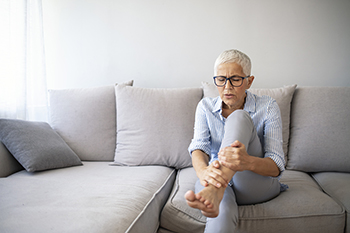
Psoriasis is a skin condition that causes red patches of skin with silvery scales. Psoriatic arthritis or PsA is a kind of inflammatory arthritis that affects people who suffer from psoriasis. PsA causes pain, swelling, and tenderness in joints, and it can affect the feet, toes, and toenails. In fact, these are some of the unique traits of this type of arthritis. When PsA leads to swelling of the toes, it is called dacylitis of the toes. This swelling, caused by tenosynovitis or inflammation of the tendon sheath, usually impacts the entire toe rather than a single joint, and the toe can look like a sausage. Psoriatic arthritis can also result in swelling and tenderness in the ankles and heels, accompanied by a red or purple tint of the skin. Furthermore, PsA sufferers can develop enthesitis, which is inflammation where the tendons and ligaments connect with bone. This often affects one's Achilles tendon, which connects the heel to the calf muscles. This, too, leads to swelling and pain in the back of the heel and ankle, as well as the sole of the foot. The effects on the feet from psoriatic arthritis are numerous. If you have developed this condition, it is strongly suggested that you have a podiatrist on your medical team who can help you navigate the uncomfortable symptoms you may feel.
Arthritis can be a difficult condition to live with. If you are seeking treatment, contact one of our podiatrists from Canonsburg Podiatry Associates. Our doctors can provide the care you need to keep you pain-free and on your feet.
Arthritic Foot Care
Arthritis is a term that is commonly used to describe joint pain. The condition itself can occur to anyone of any age, race, or gender, and there are over 100 types of it. Nevertheless, arthritis is more commonly found in women compared to men, and it is also more prevalent in those who are overweight. The causes of arthritis vary depending on which type of arthritis you have. Osteoarthritis for example, is often caused by injury, while rheumatoid arthritis is caused by a misdirected immune system.
Symptoms
- Swelling
- Pain
- Stiffness
- Decreased Range of Motion
Arthritic symptoms range in severity, and they may come and go. Some symptoms stay the same for several years but could potentially get worse with time. Severe cases of arthritis can prevent its sufferers from performing daily activities and make walking difficult.
Risk Factors
- Occupation – Occupations requiring repetitive knee movements have been linked to osteoarthritis
- Obesity – Excess weight can contribute to osteoarthritis development
- Infection – Microbial agents can infect the joints and trigger arthritis
- Joint Injuries – Damage to joints may lead to osteoarthritis
- Age – Risk increases with age
- Gender –Most types are more common in women
- Genetics – Arthritis can be hereditary
If you suspect your arthritis is affecting your feet, it is crucial that you see a podiatrist immediately. Your doctor will be able to address your specific case and help you decide which treatment method is best for you.
If you have any questions, please feel free to contact our office located in Canonsburg and McMurray, PA . We offer the newest diagnostic and treatment technologies for all your foot care needs.




